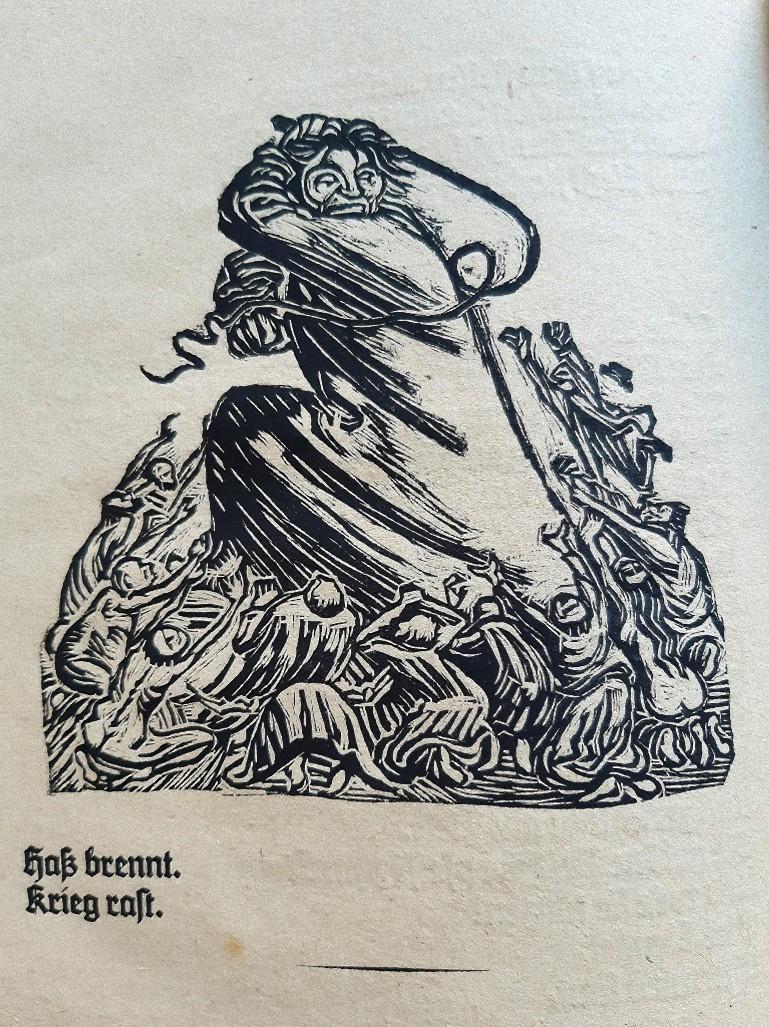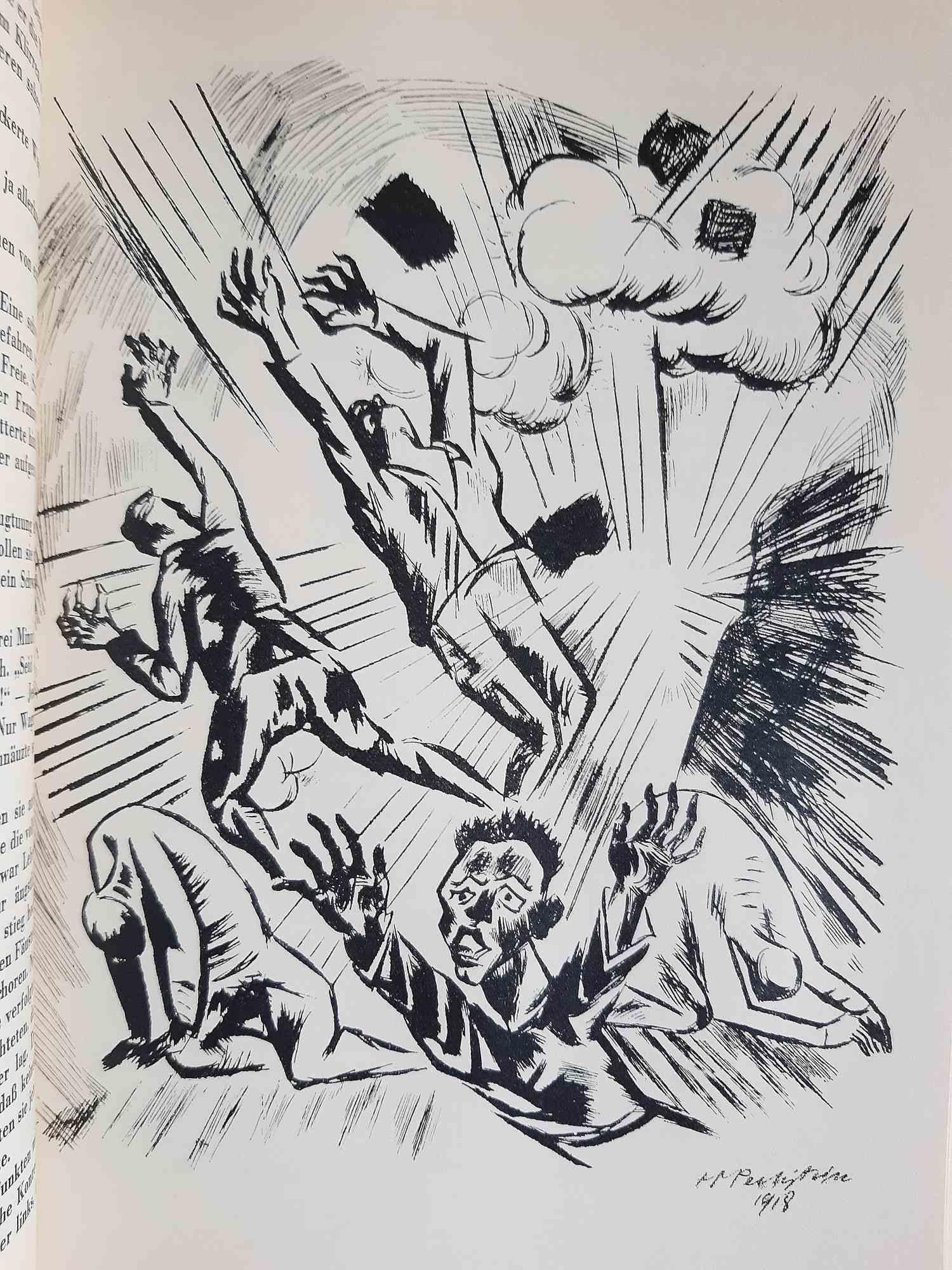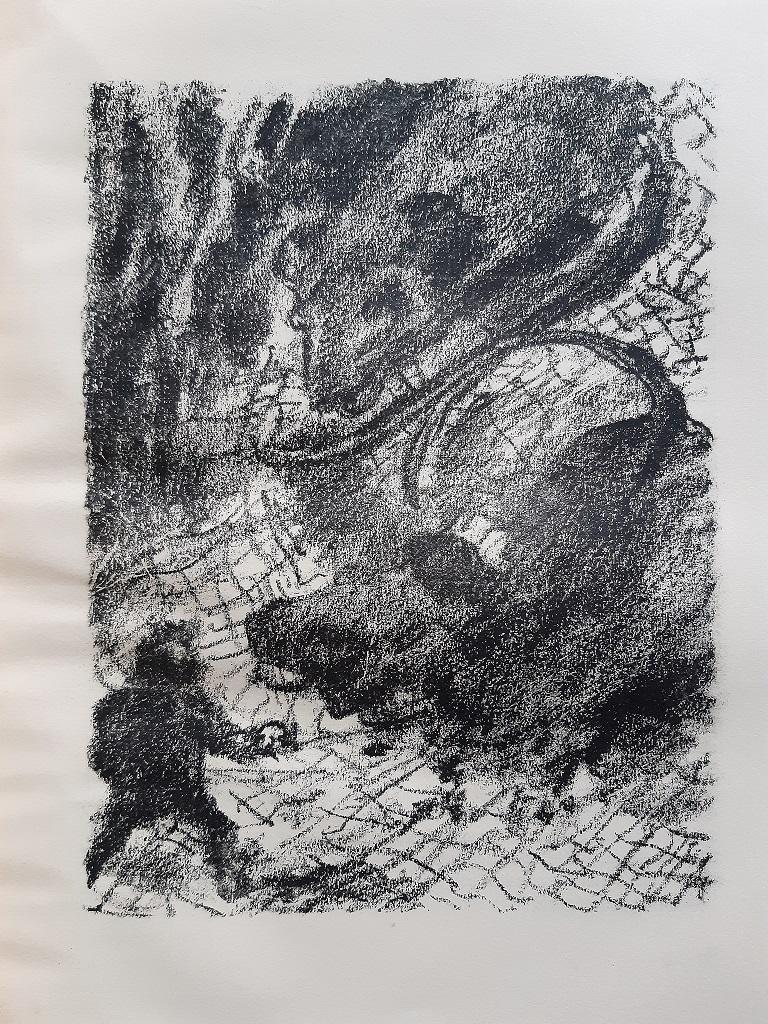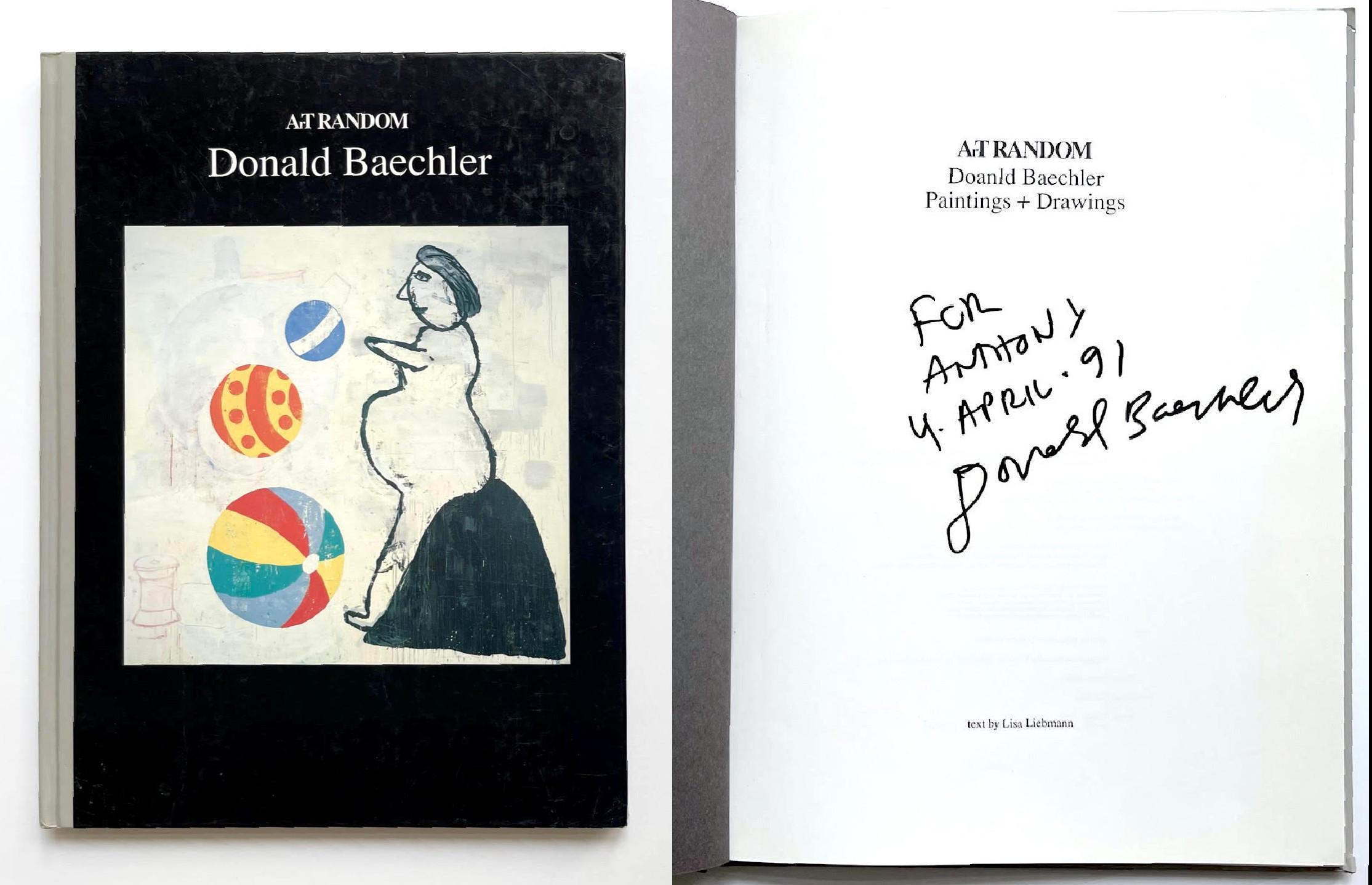Items Similar to Max Beckmann Retrospective (The Saint Louis Art Museum Sept 7-Nov. 4, 1984)
Video Loading
Want more images or videos?
Request additional images or videos from the seller
1 of 12
(after) Max BeckmannMax Beckmann Retrospective (The Saint Louis Art Museum Sept 7-Nov. 4, 1984)1984
1984
About the Item
This is a vintage museum exhibition poster from the Max Beckmann Retrospective at the Saint Louis Art Museum, 1984.
Max Beckmann was a German Expressionist painter worthy of inclusion in a great tradition - the tradition of anguished German mysticism, which first flowered in the Middle Ages. His highly personal style reflected the misery of contemporary events in Germany.
Beckmann was born in Leipzig in 1884, the youngest of three children. His father, a grain merchant, died when Beckmann was only ten years old. By the age of fifteen, after several years of boarding school and over his family's objections, he decided that his destiny lay as a painter. After failing the entrance exam for the Konigliche Akademie der Bildenden Kunste in Dresden, he was accepted by the Grossherzogliche Sachsische Kunstschule in Weimar in 1900. The School provided him with an academic art education, whereby he learned to draw from antique sculpture as well as from live models. At school, he met Minna Tube, a fellow artist whom he married in 1906 and who gave birth to his only child, Peter.
As a prosperous young man, working in the years before World War I, Beckmann was hardly a radical. He distrusted some of the young German expressionists (he called their work poster-painting) and achieved critical success with a conservative style based on impressionism. He was immensely ambitious. He wanted nothing less than to find a modern way to paint in the grand style of traditional history painting. Yet he also had a powerful expressionist streak.
Beckmann was already a success at the age of thirty when World War I broke out. He loved the street-scene turmoil and crammed his major canvases with crowds of jostling, uncongenial characters. To avoid killing, he volunteered for the medical corps and spent a year during World War I as a medical orderly; he had a nervous breakdown, and it strengthened his art. Having once viewed life as a kind of theatre, staged for the benefit of his art, he now threw himself into a furious personal struggle with the world. After the war, Beckmann portrayed city life and cafe society with mordant grace. During the 1920s he began to develop his mature style. He turned toward symbol, allegory and myth; in triptychs of the 1930s and 40s he investigated themes of freedom and constraint, the existential dilemmas of the modern artist, and the struggle between the sexes.
In 1925, Beckmann was appointed to teach in Frankfurt, a position he held until 1933. That same year, he divorced Minna Tube and married Mathilde (Quappi) von Kaulbach, who became the subject of many of his important paintings. The following year, he had his first solo exhibition in the United States, at J. B. Neumann's New Art Circle gallery in New York, thereby expanding his reputation in the international art community.
During this period Beckmann's style became richer and more complex. The example of Cezanne helped him invest his pictures with a strong linear architecture; he developed, in particular, a beautiful way with thick black lines, which gives his pictures the sluggish power of hot pitch. The example of Matisse (who used black so well) no doubt helped Beckmann master the rhythm between his increasingly lush colors. His light, in turn, became very odd. Many paintings, whatever the indication of shadow, seem lit from behind: the backlighting, the rich color and the strong black lines give some works the sturdy, but spiritual, luminosity of stained glass.
Beckmann worked in this style until the end of his life - despite increasing repression by the Nazis, since he had been branded by Hitler himself as a "degenerate painter". This prompted his immigration to Amsterdam in 1937, and in 1947 to the United States, where he taught at Washington University in St. Louis, in Brooklyn, and at Mills College in Oakland, CA. Unlike most expressionists, he did not burn out young, perhaps because he had never been just an expressionist. He sometimes painted gentle portraits and beguiling landscapes. He took pleasure in sweet as well as sour color, he favored a certain grim whimsy. His criticism is directed less at this person or that political system than at life itself. Although he himself was never an abstract painter, the New York school of abstract expressionism owes much to him for his unflagging insistence on directness and violence.
Some observers find Beckmann's enigmatic iconography a distraction from the purely visual pleasure of art. He was an artist who resolutely cast his work in a heroic mode. The self-portrait was something of a specialty with Beckmann; in them there is also an uncanny vitality and force of character.
Two days after Christmas 1950, while on a morning walk in Manhattan's Central Park, Beckmann suffered a fatal heart attack.
- Creator:(after) Max Beckmann (1884 - 1950, German)
- Creation Year:1984
- Dimensions:Height: 36 in (91.44 cm)Width: 24 in (60.96 cm)
- Medium:
- Movement & Style:
- Period:
- Condition:
- Gallery Location:Missouri, MO
- Reference Number:1stDibs: LU74732380101
About the Seller
5.0
Vetted Seller
These experienced sellers undergo a comprehensive evaluation by our team of in-house experts.
Established in 1970
1stDibs seller since 2017
142 sales on 1stDibs
Typical response time: 20 hours
- ShippingRetrieving quote...Ships From: Missouri, MO
- Return PolicyA return for this item may be initiated within 3 days of delivery.
More From This SellerView All
- Helicopters, Mountains, People (from The Valley Suite)By Keith HaringLocated in Missouri, MOHelicopters, Mountains, People (from The Valley Suite) by Keith Haring (1958-1990) Without Frame: 10" x 8.75" With Frame: 18.25" x 17.25" Signed and Dated Lower Right Edition 31/80 Lower Left "The Valley" is a group of etchings...Category
Late 20th Century Pop Art Figurative Prints
MaterialsEngraving
- Study/Falling Man (Series II)By Ernest Tino TrovaLocated in Missouri, MOStudy/Falling Man (Series II), 1967 By. Ernest Tino Trova (American, 1927-2009) Signed in Pencil Lower Right Color Lithograph Unframed: 6 x 6 inches With Frame: 8.75 x 8.5 inches Kn...Category
20th Century American Modern Abstract Prints
MaterialsLithograph
- Study/Falling Man (Series I)By Ernest Tino TrovaLocated in Missouri, MOStudy/Falling Man (Series I), 1967 By. Ernest Tino Trova (American, 1927-2009) 24 x 24 inches Wrapped to Foam Core Signed Artist Proof Lower Right Ernest Tino Trova (American, 1927-...Category
1960s American Modern Abstract Prints
MaterialsScreen
- Study/Falling Man (Series II)By Ernest Tino TrovaLocated in Missouri, MOStudy/Falling Man (Series II) By. Ernest Tino Trova (American, 1927-2009) 24 x 24 inches Wrapped to Foam Core Signed Artist Proof Lower Right Ernest Tino Trova (American, 1927-2009)...Category
1960s American Modern Abstract Prints
MaterialsScreen
- Bareback Act, Old HippodromeBy Gifford BealLocated in Missouri, MOBareback Act, Old Hippodrome By Gifford Beal (1879-1956) Signed Lower Right Unframed: 6.5" x 9.5" Framed: 17.5" x 20" Gifford Beal, painter, etcher, muralist, and teacher, was born in New York City in 1879. The son of landscape painter William Reynolds Beal, Gifford Beal began studying at William Merritt Chase's Shinnecock School of Art (the first established school of plein air painting in America) at the age of thirteen, when he accompanied his older brother, Reynolds, to summer classes. He remained a pupil of Chase's for ten years also studying with him in New York City at the artist's private studio in the Tenth Street Studio Building. Later at his father's behest, he attended Princeton University from 1896 to 1900 while still continuing his lessons with Chase. Upon graduation from Princeton he took classes at the Art Students' League, studying with impressionist landscape painter Henry Ward Ranger and Boston academic painter Frank Vincent DuMond. He ended up as President of the Art Students League for fourteen years, "a distinction unsurpassed by any other artist." His student days were spent entirely in this country. "Given the opportunity to visit Paris en route to England in 1908, he chose to avoid it" he stated, "I didn't trust myself with the delightful life in ParisIt all sounded so fascinating and easy and loose." His subjects were predominately American, and it has been said stylistically "his art is completely American." Gifford achieved early recognition in the New York Art World. He became an associate member of the National Academy of Design in 1908 and was elected to full status of academician in 1914. He was known for garden parties, circuses, landscapes, streets, coasts, flowers and marines. This diversity in subject matter created "no typical or characteristic style to his work." Beal's style was highly influenced by Chase and Childe Hassam, a long time friend of the Beal family who used to travel "about the countryside with Beal in a car sketching...Category
20th Century American Modern Animal Prints
MaterialsLithograph
- Le Christ a l'Horloge, ParisBy Marc ChagallLocated in Missouri, MOMarc Chagall "Le Christ a l'Horloge, Paris" (Christ in the Clock) 1957 (M. 196) Color Lithograph on Arches Wove Paper Signed in Pencil "Marc Chagall" Lower Right Initialed "H.C." (Hors Commerce) Lower Left, aside from numbered edition of 90 *Floated in Gold Frame with Linen Matting, UV Plexiglass Sheet Size: 18 3/4 x 14 3/4 inches (47.5 cm x 38 cm) Image Size: 9 3/4 x 8 1/2 inches Framed Size: 28.5 x 24.25 inches Marc Chagall was a man of keen intelligence, a shrewd observer of the contemporary scene, with a great sympathy for human suffering. He was born on July 7, 1887 in Vitebsk, Russia; his original name was Moishe Shagal (Segal), but when he became a foremost member of the Ecole de Paris, he adopted French citizenship and the French spelling of his name. Vitebsk was a good-sized Russian town of over 60,000, not a shtetl. His father supported a wife and eight children as a worker in a herring-pickling plant. Sheltered by the Jewish commandment against graven images, the young Chagall never saw so much as a drawing until, one day, he watched a schoolmate copying a magazine illustration. He was ridiculed for his astonishment, but he began copying and improvising from magazines. Both Chagall's parents reluctantly agreed to let him study with Yehuda Pen, a Jewish artist in Vitebsk. Later, in 1906, they allowed their son to study in St. Petersburg, where he was exposed to Russian Iconography and folk art. At that time, Jews could leave the Pale only for business and employment and were required to carry a permit. Chagall, who was in St. Petersburg without a permit, was imprisoned briefly. His first wife, Bella Rosenfeld, was a product of a rich cultivated and intellectual group of Jews in Vitebsk. Chagall was made commissar for the arts for the area, charged with directing its cultural life and establishing an art school. Russian folklore, peasant life and landscapes persisted in his work all his life. In 1910 a rich patron, a lawyer named Vinaver, staked him to a crucial trip to Paris, where young artists were revolutionizing art. He also sent him a handsome allowance of 125 francs (in those days about $24) each month. Chagall rejected cubism, fauvism and futurism, but remained in Paris. He found a studio near Montparnasse in a famous twelve-sided wooden structure divided into wedge-shaped rooms. Chaim Soutine, a fellow Russian Jew, and Modigliani lived on the same floor. To Chagall's astonishment, he found himself heralded as one of the fathers of surrealism. In 1923, a delegation of Max Ernst, Paul Eluard and Gala (later Salvador Dali's wife) actually knelt before Chagall, begging him to join their ranks. He refused. To understand Chagall's work, it is necessary to know that he was born a Hasidic Jew, heir to mysticism and a world of the spirit, steeped in Jewish lore and reared in the Yiddish language. The Hasidim had a special feeling for animals, which they tried not to overburden. In the mysterious world of Kabbala and fantastic ancient legends of Chagall's youth, the imaginary was as important as the real. His extraordinary use of color also grew out of his dream world; he did not use color realistically, but for emotional effect and to serve the needs of his design. Most of his favorite themes, though superficially light and trivial, mask dark and somber thoughts. The circus he views as a mirror of life; the crucifixion as a tragic theme, used as a parallel to the historic Jewish condition, but he is perhaps best known for the rapturous lovers he painted all his life. His love of music is a theme that runs through his paintings. After a brief period in Berlin, Chagall, Bella and their young daughter, Ida, moved to Paris and in 1937 they assumed French citizenship. When France fell, Chagall accepted an invitation from the Museum of Modern Art to immigrate to the United States. He was arrested and imprisoned in Marseilles for a short time, but was still able to immigrate with his family. The Nazi onslaught caught Chagall in Vichy, France, preoccupied with his work. He was loath to leave; his friend Varian Fry rescued him from a police roundup of Jews in Marseille, and packed him, his family and 3500 lbs. of his art works on board a transatlantic ship. The day before he arrived in New York City, June 23, 1941, the Nazis attacked Russia. The United States provided a wartime haven and a climate of liberty for Chagall. In America he spent the war years designing large backdrops for the Ballet. Bella died suddenly in the United States of a viral infection in September 1944 while summering in upstate New York. He rushed her to a hospital in the Adirondacks, where, hampered by his fragmentary English, they were turned away with the excuse that the hour was too late. The next day she died. He waited for three years after the war before returning to France. With him went a slender married English girl, Virginia Haggard MacNeil; Chagall fell in love with her and they had a son, David. After seven years she ran off with an indigent photographer. It was an immense blow to Chagall's ego, but soon after, he met Valentine Brodsky, a Russian divorcee designing millinery in London (he called her Fava). She cared for him during the days of his immense fame and glory. They returned to France, to a home and studio in rustic Vence. Chagall loved the country and every day walked through the orchards, terraces, etc. before he went to work. Chagall died on March 28, 1985 in the south of France. His heirs negotiated an arrangement with the French state allowing them to pay most of their inheritance taxes in works of art. The heirs owed about $30 million to the French government; roughly $23 million of that amount was deemed payable in artworks. Chagall's daughter, Ida and his widow approved the arrangement. Written and submitted by Jean Ershler Schatz, artist and researcher from Laguna Woods, California. Sources: Hannah Grad Goodman in Homage to Chagall in Hadassah Magazine, June 1985 Jack Kroll in Newsweek, April 8, 1985 Andrea Jolles in National Jewish Monthly Magazine, May 1985 Michael Gibson...Category
1950s Modern Figurative Prints
MaterialsLithograph
You May Also Like
- Book: Francis Bacon von [with] John Russell (hand signed and inscribed twice)By Francis BaconLocated in New York, NYHighly collectible and coveted item: Francis Bacon von [with] John Russell (Monograph, hand signed and inscribed twice by Francis Bacon), 1972 Hardback monograph with dust jacket (ha...Category
1970s Expressionist Figurative Prints
MaterialsInk, Mixed Media, Lithograph, Offset
- Der Kopf - Rare Book Illustrated by Ernst Barlach - 1919By Ernst BarlachLocated in Roma, ITDer Kopf is an original Rare Book llustrated by the Expressionist German artist Ernst Barlach (1870- 1938) and written by Reinhold von Walter (St. Petersburg, 1882 - Ravensburg, 196...Category
1910s Expressionist More Art
MaterialsWoodcut
- Die Grosse Befehl - Illustrated Book by Max Pechstein - 1933By Hermann Max PechsteinLocated in Roma, ITDie Grosse Befehl is an original Rare Book illustrated by Hermann Max Pechstein (Zwickau, December 31, 1881 – Berlin, June 29, 1955) and written by Johanne...Category
1930s Expressionist Figurative Prints
MaterialsPaper
- Gullivers Reise - Rare Book Illustrated by Lovis Corinth - 1922By Lovis CorinthLocated in Roma, ITGullivers Reise is an original modern rare book written by Jonathan Swift (Dublin, 1667 – Dublin, 1745) and illustrated by Lovis Corinth (21 July 1858 –...Category
1920s Expressionist More Art
MaterialsPaper
- Venuswagen - Rare Book Illustrated by Lovis Corinth - 1919By Lovis CorinthLocated in Roma, ITVenuswagen is an original modern rare book written by Johann Christoph Friedrich (von) Schiller (1759 – 1805) and illustrated by Lovis Corinth (21 July 1858 – 17 July 1925) in 1919....Category
1910s Expressionist More Art
MaterialsLithograph, Paper
- ArT RANDOM Donald Baechler Japanese catalog (hand signed and inscribed)By Donald BaechlerLocated in New York, NYDonald Baechler ArT RANDOM Donald Baechler Japanese catalog (hand signed and inscribed to writer and art critic Anthony Haden-Guest), 1989 Hardback monograph Hand signed and inscribed to writer and art critic Anthony Haden-Guest 12 × 9 1/4 × 1/2 inches Unframed This uncommon 1989 Japanese hardback monograph with no dust jacket as issued, is hand signed and inscribed by artist Donald Baechler to the art critic Anthony Haden-Guest. Inscription reads: For Anthony 4.April. 91 Donald Baechler Book information: First edition. Published by Kyoto: Kyoto Shoin International Co., Ltd., 1989. Hardcover. Photographically illustrated paper-covered boards; no dust jacket as issued. Paintings and drawings by Donald Baechler. Text (in English and Japanese) by Lisa Liebmann. Unpaginated (48 pp.), with 36 four-color plates. About Donald Baechler: Donald Baechler was one of the most promising artists of the 1980s. He was associated with a group of painters in New York that included Julian Schnabel, David Salle, Jean-Michel Basquiat and Philip Taaffe...Category
1980s Pop Art Figurative Prints
MaterialsMixed Media, Permanent Marker, Lithograph, Offset
Recently Viewed
View AllMore Ways To Browse
Vintage Museum Exhibition Posters
Vintage Circle Print
Lit Louis
Stained Glass Circles
New York Central Poster
St Louis Poster
Peter Max 1980
Vintage Landscape Posters
Dior Sex And City
Dior Sex And The City
Vintage Medical Light
Antique Painted Portrait Of A Child
Vintage 40s Posters
Christmas Posters
4 Freedoms Posters
Vintage St Louis Posters
Cafe Vintage Poster
Odd Fellows
![Book: Francis Bacon von [with] John Russell (hand signed and inscribed twice)](https://a.1stdibscdn.com/francis-bacon-prints-works-on-paper-book-francis-bacon-von-with-john-russell-hand-signed-and-inscribed-twice-for-sale/a_17452/a_130412521694307115175/axScsafc_master.jpg)




